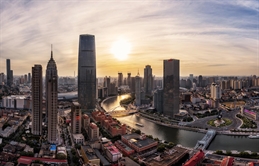
Initially, startling ideas were among the visions as to how data and automation will impact the logistics industry in the future, separate year-end webinars were told.
Leading the way were two almost outlandish ideas put forward by Pepijn Kip, a researcher at Amsterdam-based Bit, a research and prototyping firm, during a webinar hosted by the Holland International Distribution Council (HIDC).
One of these ideas was living containers, an idea in which patches attached to products that recognize not just when food is spoiling but when it has E. coli and salmonella growing in it.
This could be adapted and expanded and lead to containers that change colour when the cargo is deteriorating, Kip said, describing an important commercial application. “Containers might get senses that outperform the senses of humans,” he said.
Initially, this is very much the sort of technology relevant to perishables but which could be extended to other sectors and other settings. Airbus, for example, is working on something similar with an on-plane sensor able to detect drugs and explosives, he said.
Kip’s other item of discussion was self-repairing cars. This sounds straight out of the latest science-fiction epic at the local multiplex, starting with aluminium able to repair itself, but which leads to vehicles with a much longer life span – and, presumably other as yet unknown skills.
Farfetched though both sound, there are good precedents for this kind of thinking. One emerging now with serious commercial implications is autonomous vehicles, which are already working in some ports and railway lines. Kip’s prediction was that in 15 years, fully autonomous logistics trucks will drive in convoys.
Another precedent should make any scoffer stop. Thirty years ago, mobile phones were just starting to make their presence felt in business; now, they are all in museums or junk shops with everyone, including school children, carrying a powerful portable computer called a smartphone in their pocket.
The industry must better harvest the waves of data these technologies create – and use them to prosper.
“How do we bring it all to life?” asked Pinak Deshmane, director, analytics, at 3SC Analytics in Amsterdam. “How do we make sense of all that data?” Deshmane offered his prediction that 2021 is going to be challenged by more than just Covid-19 and trade tensions, including dealing with the waves of new tech and a coming data deluge.
All this brings challenges for the ports, as a webinar organized by Transport Events heard.
There was an agreement for the idea of data and how to deal with the deluge of data starting to work its way through the system as a key and disruptive part of the immediate future, which will be data-driven and will require change management, said Mark Welles, vice president of global partnerships for Navis in Hong Kong.
Details were outlined by another Navis speaker, Meena Shah, a UK-based sales engineer, with the impact of the workforce and the shift they need to make being very much to the fore.
“We often see terminals need to hire for new skills when confronted with the new data reality, especially data science and analytics,” said Shah. It will also require another skill set of managers as they deal with staff freed from the routine work now done by automation.
Some Asian ports are already there – and maybe even beyond, with Tianjin Port “actively exploring and experimenting with advanced technology,” said Jiaqi Jiang, its head of software development.
That a port has its own head of software is a sign of what is going to change, although Jiang was practical about where to look and what to work on first.
Next year, Tianjin will pilot full automation of side-landing in operation at its TSCT facility, Jiang said. It will also launch three-yard automation processes which involve RMG retrofitting, RTG retrofitting and Dual C-ARMG at its FICT, TPCT and TSCT units, respectively.
Tianjin has decided to focus on its unmanned trucks, of which it already has and uses 25.
It not though unaware of the challenges these bring, which Jiang listed as including alignment and collaboration with unmanned and horizontal automation equipment such as ARMGs and Automatic STSs, traffic control and electronic charging technology.
“Unmanned vehicles do not have a universal wheel and cannot move in all directions at this time, so we just have to design and define new processes for route planning, vehicle sequence controlling and traffic control,” he said.
By Michael Mackey
Southeast Asia Correspondent | Bangkok



